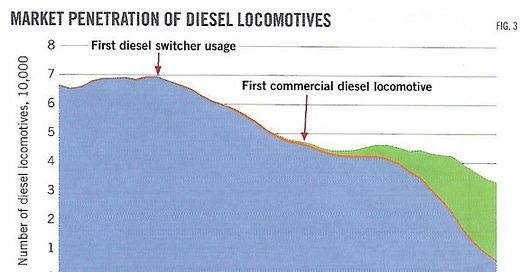It Takes Time: Steam to Diesel
A theme of the posts at this site is that we cannot switch from one source of energy to another overnight, or even in just a few years. The time it took the American railroad industry to switch from steam to diesel power illustrates this point.
One of the foundations of the industrial revolution was the steam-powered railway locomotive. Yet, by the start of the 20th century it was clear that diesel-powered locomotives were more efficient, and that they should replace steam.
The following chart, which is taken from the November 2018 issue of the Oil & Gas Journal, shows how long it took for the railroad industry in the United States to switch from steam to diesel-electric motive power.
Diesel and diesel-electric locomotives are attractive economically when compared to steam locomotives, largely because they require much less downtime for routine maintenance and cleaning. The chart shows that diesel locomotives were put into use around the year 1925. Yet it was not until 1937 that mainline diesel locomotives entered service. After that, diesel locomotives steadily replaced their steam counterparts. But, even by the year 1955, that replacement was not complete. (The chart shows that the total number of locomotives of both types fell from nearly 70,000 to 3,500. This is presumably because the power of the individual motive power units, both steam and diesel, steadily increased.)
During this transition, most other aspects of railroad technology and operations such as the track, the freight cars, the signaling systems, and even the Union contracts did not have to change at all. Yet this relatively modest change took decades to implement. If it takes 30 years to transform a single industry, the challenge to do with transforming our entire industrial infrastructure in the same amount of time can only be described as being forbidding.
If it takes half a century for the railroads to switch from steam to diesel power, how long will it take to transition the entire economy to renewable sources of energy, an economy in which there is no place for fossil fuels?





